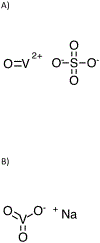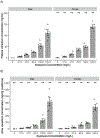Systemic exposure and urinary excretion of vanadium following perinatal subchronic exposure to vanadyl sulfate and sodium metavanadate via drinking water
- PMID: 35331842
- PMCID: PMC9036617
- DOI: 10.1016/j.toxlet.2022.03.004
Systemic exposure and urinary excretion of vanadium following perinatal subchronic exposure to vanadyl sulfate and sodium metavanadate via drinking water
Erratum in
-
Corrigendum to "Systemic exposure and urinary excretion of vanadium following perinatal subchronic exposure to vanadyl sulfate and sodium metavanadate via drinking water" [Toxicol. Lett. 360 (2022) 53-61].Toxicol Lett. 2023 Jan 15;373:210. doi: 10.1016/j.toxlet.2022.11.008. Epub 2022 Nov 24. Toxicol Lett. 2023. PMID: 36435680 Free PMC article. No abstract available.
Abstract
Vanadium is a ubiquitous environmental contaminant although there are limited data to assess potential adverse human health impact following oral exposure. In support of studies investigating the subchronic toxicity of vanadyl sulfate (V4+) and sodium metavanadate (V5+) following perinatal exposure via drinking water in male and female rats, we have determined the internal exposure and urinary excretion of total vanadium at the end of study. Water consumption decreased with increasing exposure concentration following exposure to both compounds. Plasma and urine vanadium concentration normalized to total vanadium consumed per day increased with the exposure concentration of vanadyl sulfate and sodium metavanadate suggesting absorption increased as the exposure concentration increased. Additionally, females had higher concentrations than males (in plasma only for vanadyl sulfate exposure). Animals exposed to sodium metavanadate had up to 3-fold higher vanadium concentration in plasma and urine compared to vanadyl sulfate exposed animals, when normalized to total vanadium consumed per day, demonstrating differential absorption, distribution, metabolism, and excretion properties between V5+ and V4+ compounds. These data will aid in the interpretation of animal toxicity data of V4+ and V5+ compounds and determine the relevance of animal toxicity findings to human exposures.
Keywords: Plasma vanadium; Sodium metavanadate; Urine vanadium; Vanadate; Vanadyl; Vanadyl sulfate.
Published by Elsevier B.V.
Conflict of interest statement
Declaration of interests
The authors declare that they have no known competing financial interests or personal relationships that could have appeared to influence the work reported in this paper.
Figures






References
-
- Adachi A, Ogawa K, Tsushi Y, Nagao N, Okano T, 2000. Balance, excretion andtissue distribution of vanadium in rats after short-term ingestion. J. HealthSci. 46, 59–62.
-
- ATSDR, 2012. Agency for Toxic Substances and Disease Registry (ATSDR). A ToxicologicalProfile for Vanadium, U.S. Department of Health and Human Services, PublicHealth Service, ATSDR, Atlanta, GA.
-
- Azay J, Bres J, Krosniak M, Teissedre PL, Cabanis JC, Serrano JJ, Cros G, 2001. Vanadium pharmacokinetics and oral bioavailability upon single-dose administration of vanadyl sulfate to rats. Fundam Clin Pharmacol 15, 313–324. - PubMed
-
- Crans DC, Smee JJ, Gaidamauskas E, Yang L, 2004. The chemistry and biochemistry of vanadium and the biological activities exerted by vanadium compounds. Chem Rev 104, 849–902. - PubMed
-
- Dixon WJ, Massey FJ, 1957. Introduction to statistical analysis. New York, NY: McGraw Hill Book Company Inc.
MeSH terms
Substances
Grants and funding
LinkOut - more resources
Full Text Sources
Medical

